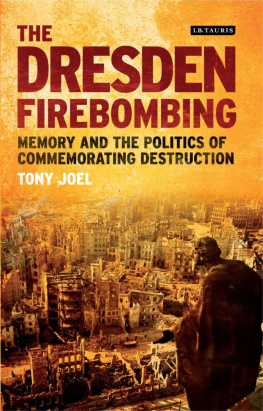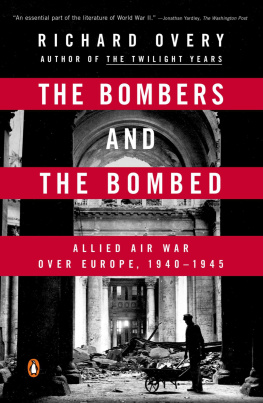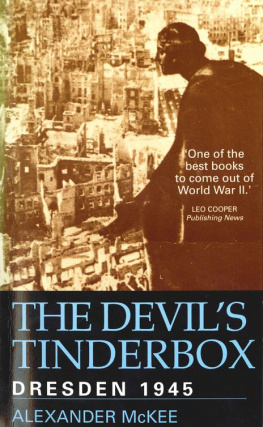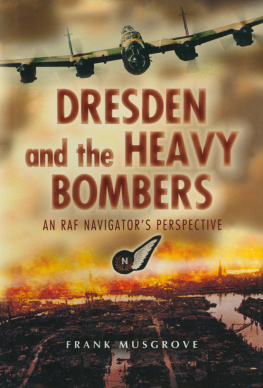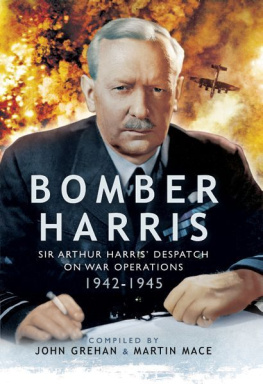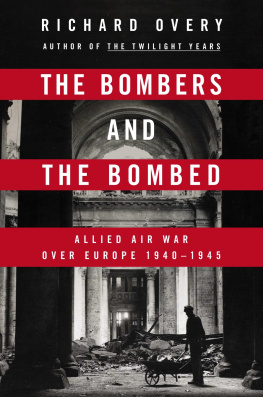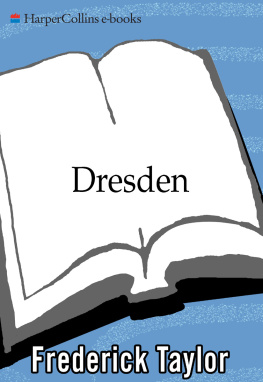Tony Joel is Senior Lecturer in History at Deakin University, Australia. A former German Academic Exchange Service (DAAD) scholarship holder, and a member of the Alfred Deakin Research Institute, his research interests include war memory and commemoration.

Published in 2013 by I.B.Tauris & Co. Ltd
6 Salem Road, London W2 4BU
175 Fifth Avenue, New York NY 10010
www.ibtauris.com
Distributed in the United States and Canada Exclusively by Palgrave Macmillan,
175 Fifth Avenue, New York NY 10010
Copyright Tony Joel 2013
The right of Tony Joel to be identified as the author of this work has been asserted by him in accordance with the Copyright, Designs and Patents Act, 1988.
All rights reserved. Except for brief quotations in a review, this book, or any part thereof, may not be reproduced, stored in or introduced into a retrieval system, or transmitted, in any form or by any means, electronic, mechanical, photocopying, recording or otherwise, without the prior written permission of the publisher.
ISBN 978 178076 358 3
eISBN 978 085773 635 2
A full CIP record for this book is available from the British Library
A full CIP record for this book is available from the Library of Congress
Library of Congress catalog card: available
Contents
If dreams are like movies, then memories are films about ghosts.
Adam F. Duritz, Mrs Potters Lullaby
List of illustrations
: Churchills drafted memo denouncing the destruction of Dresden and the more discreet redraft. Photographs taken of originals (stored in the National Archives, London): Tony Joel, January 2006.
: Denkmal for Dresdens bombing victims out at the Heidefriedhof. Photograph: Tony Joel, 13 February 2006.
: Trmmerfrau statue in front of Dresdens Rathaus. Photograph: Tony Joel, 14 February 2006.
: Two of the 14 pillars marking the Rondell. Photographs: Tony Joel, 13 February 2006.
: Dresdens rebuilt state opera house, the Semperoper, reopened on 13 February 1985. Photograph: Tony Joel, 13 February 2005.
: The rebuilt Hofkirche. Photograph: Tony Joel, 13 February 2006.
: The Mahnmal on the site of the original Dresden synagogue destroyed on Kristallnacht, 9 November 1938. Photograph: Tony Joel, 13 February 2006.
: Fighter Command statue of Lord Dowding with the RAF church St Clement Danes in the background. Photograph: Tony Joel, December 2005.
: Scars of war: pockmarks from the Battle of Britain still evident on the exterior of St Clement Danes. Photograph: Tony Joel, December 2005.
: Plaque on the pedestal of the BCAs memorial dedicated to Harris and his wartime crew members, especially the fallen. Photograph: Tony Joel, December 2005.
: BCA royal patron the Queen Mother, escorted by Sir Michael Beetham.
: Delivers her address prior to unveiling the Harris statue. Photographs: in possession of the author, provided by Douglas Radcliffe.
: Dresdens reconstructed Frauenkirche. Photograph: Tony Joel, 13 February 2006.
: Close-up showing the blackened patina formed on original stones reused in the rebuilding of the Frauenkirche, contrasting starkly with the light golden colour of the new sandstone blocks. Photograph: Tony Joel, October 2009
Acknowledgements
It is with great pleasure that I now have the opportunity to thank publicly the individuals and institutions who, directly and indirectly, have contributed to the construction of this book.
First, my most recent debt of gratitude is to editors Lester Crook and in particular Tomasz Hoskins at I.B.Tauris. Lesters initial enthusiasm got the publishing process underway, and since adopting the project, Tomasz has skilfully overseen it through to completion. Tomaszs strong interest in my work, his patience, encouragement, and editorial expertise have been greatly appreciated. I would also like to thank everyone else at I.B.Tauris involved in preparing this work for publication. And I am grateful to Lisa Couacaud for such a meticulous job in compiling the index. In addition to any reviewers who remained anonymous, I would also like to express my thanks to Professor Mary Fulbrook (University College London), Professor Bill Niven (Nottingham Trent University), and Professor Klaus Neumann (Swinburne University of Technology), whose earlier comments and suggestions were not only thought-provoking and helpful but also reassuring.
Most of the research conducted for this book was made possible courtesy of very generous funding from the DAAD (German Academic Exchange Service/Deutscher Akademischer Austausch Dienst). I am extraordinarily indebted to Prof. Dr Jost Dlffer (Universitt zu Kln), who kindly supported my DAAD application and continues to be a pillar of support and advice. From afar, Jost has probably had a more profound impact on this study (and my growth as a historian more generally) than he realises. My thanks extend to the friendly and helpful staff at the Institut fr Zeitungsforschung der Stadt Dortmund. Furthermore, Vera Bertram (Broadview-TV GmbH), Prof. Dr Marc Frey (now Jacobs University Bremen), Prof. Dr Ralph Jessen (Universitt zu Kln), Prof. Dr Guido Knopp, Prof. Dr Snke Neitzel (currently LSE, London), and Prof. Dr Reiner Pommerin (TU Dresden) all provided valuable information and/or kind words of encouragement along the way. Two research trips to Britain were made all the more enjoyable and productive thanks to the helpful staff at The National Archives and the British Library Newspaper Reading Room in Colindale. I am also extremely grateful for the warm hospitality afforded by Douglas Radcliffe MBE at his office in the RAF Museum, London, and also Dr Alan Russell OBE at his home (Dresden House) in Chichester.
I owe a particular debt of gratitude to Deakin University for providing a tremendously supportive and stimulating working environment. Administrative staff in the Faculty of Arts and Education along with Deakin librarians (especially faculty liaison staff and the interlibrary loans department) are helpful always. I feel privileged to belong to the School of Humanities and Social Sciences, working for and with HOS Professor Matthew Clarke and SEO Helen Andrew. Of great importance to me is the collegiality enjoyed among Deakin historians. I have had the good fortune of being closely involved with the Alfred Deakin Research Institute (ADRI) since its founding, and in particular its Contemporary Histories Research Group. There are simply too many wonderful Deakin colleagues to thank individually, but a select few are deserving of special mention. I am lucky to count among my closest teaching collaborators Dr William (Bill) Anderson, Dr Donna-Lee Frieze, Dr Helen Gardner, Dr Mark Humphries, Assoc. Professor Chris Waters, and my fellow long-suffering Tigers fan Dr Bart Ziino. Several colleagues, past and present, have aided my progress and shaped my thinking as a historian more than they perhaps realise, including Assoc. Professor Rohan Bastin, Professor Alan Booth, Dr Barry Butcher, Dr Ray Duplain, Roy Hay, Assoc. Professor Michele Langfield, Professor William (Bill) Logan, Tony Neylan, and especially Professor Sarah Paddle. And Dr Murray Noonan and Dr Chad Whelan have remained good personal friends since our days together as PhD students. To teach is to learn, and so it would be most remiss of me not to acknowledge the many students who have influenced my views on modern German history and the politics of the past.

